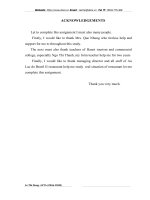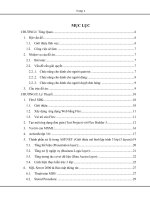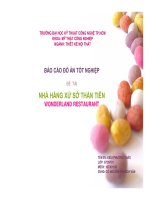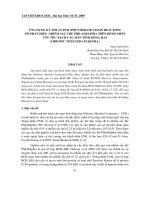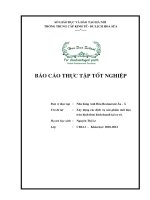Philadelphia Magazines Ultimate Restaurant Guide41234
Bạn đang xem bản rút gọn của tài liệu. Xem và tải ngay bản đầy đủ của tài liệu tại đây (6.29 MB, 191 trang )
Edited by
April White
Foreword by food critic
Maria Gallagher
Copyrighted Material
Philadelphia magazine's
Ultimate Restaurant Guide
Copyrighted Material
Copyrighted Material
Philadelphia magazine's
ULTIMATE
RESTAURANT
~~~~~o~~~~~a~:~~"'9h.'
liiiiil
m
GUIDE
Temple University Press
Philadelphia
Copyrighted Material
Temple University Press
1601 North Broad Street
Philadelphia PA 19122
www.temple.edu/tempress
Copyright © 2004 by Metro Corp.
All rights, to collective work and individual contributions, reserved
Published 2004
Printed in the United States of America
Cover and text design by Andrew Zahn
Photography by Zoey Sless-Kitain
Philadelphia® magazine and Best of Philly® are registered
trademarks of Metro Corp.
eThe paper used in this publication meets the requirements of the
American National Standard for Information Sciences-Permanence
of Paper for Printed Library Materials, ANSI Z39.48-1992
Library of Congress Cataloging-in-Publication Data
Philadelphia magazine's ultimate restaurant guide / edited by
April White; foreword by Maria Gallagher.
p. em.
Includes index.
ISBN 1-59213-146-8 (alk. paper)
1. Restaurants-Pennsylvania-Philadelphia-Guidebooks.
1. Philadelphia. II. Title.
TX907.3.P4W492004
647.95748'11-dc22
2004049794
246897531
Copyrighted Material
To those with whom I have shared the most memorable meals:
spaghetti and meatballs on Christmas Eve; lunch on the grill at camp;
omelets in Africa; pepperoni and mushroom pizza from Paolo's; and
boxes and boxes of clementines.
Copyrighted Material
Copyrighted Material
[ CONTENTS
Foreword by Maria Gallagher·
.
..
ix
1 : THE PEOPLE
.. ·3
"Everybody Went to Bookie's" by Amy Donohue
.. ·13
What's Eating Georges Perrier? by Benjamin Wallace··
...... 27
The Last Neil Stein Story by Stephen Rodrick
. .. ·44
The Reincarnation of Stephen Starr by Larry Platt· .
The Mysterious Mr. Chodorow by Amy Donohue· . ......... .. ·55
2 : THE INGREDIENTS
The Great Grape Hunt by Benjamin Wallace
Chocolates With a Conscience by Victor Fiorillo
Thank You for Smoking by Sasha Issenberg·
Four-Star Farmers by Amy Donohue·········
Miracle of the Loaves by April White
Hot Potatoes by Francine Maroukian· ..
.
Caffeine High by Benjamin Wallace·
Brewery Town by Victor Fiorillo·
···67
·72
.
···76
·80
·····84
.
.
.
····87
···90
···94
3 : THE RESTAURANTS
Is Philadelphia a Great Restaurant Town or What?
by John Mariani·
.
The Reviews....
.
Index by Cuisine..
..
Index by Neighborhood··
..
.
Acknowledgements·
.
Copyrighted Material
·99
101
·169
.. ·173
.
·177
Copyrighted Material
FOREWORD
By Maria Gallagher
Philadelphia loves to eat. Give us a plate of roasted free-range
Lancaster County chicken and a Jersey tomato salad, and we're happy; set a
cheesesteak oozing with Whiz before us, and we're ecstatic. Our two bestknown restaurants, Le Bec-Fin and Pat's Steaks, epitomize the range of our
collective appetite. Our former mayor, now Pennsylvania's governor, is such
a joyful omnivore that Wawa named a hoagie after him. We love eating so
much that we'll even get up at 5 a.m. to watch other people do it: 20,000
spectators attended Wing Bowl 2004.
My education in Philadelphia food and restaurants began in the spring of
1976, the year I moved to a one-room apartment at 13th and Walnut and
began working as an intern at Philadelphia magazine. Single and in my
early 20s, I was precisely the type of customer who would feed the city's
Restaurant Renaissance, though at the time my meager income couldn't feed
it very much.
That year, the city's top fine-dining destinations included Le Bec-Fin, La
Panetiere, the Garden, and Ristorante da Gaetano, but a group of young provocateurs-informal restaurants with a distinctly American style-were generating the most excitement. At Frog, Knave of Hearts, Lickety Split, Astral
Plane, Judy's, Friday Saturday Sunday, and Under the Blue Moon, kitchens
were turning out eclectic flavor combinations perfectly suited to the mismatched place settings and on-a-shoestring decor of their dining rooms.
Cooks were often self-taught, or fresh out of Philadelphia's new culinary arts
academy, the Restaurant School. Servers wore jeans. Blackboard menus were
updated throughout the evening to accommodate inspiration-or expunge
dishes that flopped. Many tastes of that time linger in my memory: Chestnut
soup with chicken and cardamom at the Gold Standard on 47th Street near
Chester Avenue. Swiss chard ravioli with tarragon cream sauce at Russell's at
17th and Lombard. Tall wedges of quiche-like shrimp, tomato and cheese pie
atthe Fish Market. The daring shad roe pate at In Season on 13th Street near
Pine. Frog's fiery Siamese chicken curry. The Commissary's carrot cake.
Most of these restaurants are closed now, but how we eat today dates
directly from that transformative period, commonly called the Restaurant
Renaissance. It was really a rebellion, led by restless individualists bored
Copyrighted Material
Ultimate Restaurant Guide Ix
with the city's staid steakhouses, well-worn oyster bars, and hotel dining
rooms serving predictable Continental cuisine. 'the unorthodox new restaurants were an extension of the anti-establishment sentiment generated by the
Vietnam War, but they also reflected shifts in society occurring nationwide
at that time.
Americans were traveling and tasting European and Asian cuisines in
their native environments, often during year-abroad studies. Asian emigres
who fled conflicts in Vietnam and Thailand went to work in American
restaurants, and later opened their own. Chefs began building menus
around what was fresh and in season, spurning dried herbs and prepared
products. In Philadelphia and elsewhere, jacket-and-tie requirements were
jettisoned. Dinner became a destination, instead of a pit stop before a movie.
Busy double-income couples and families were eating more meals away
from home. Gays and lesbians came out, and went out.
After I began writing restaurant reviews for the Philadelphia Daily News
in 1980, I saw firsthand how restaurants could re-energize a neighborhood,
and how neighborhood gentrification could spawn restaurants. In the
1970s, the "in" spots were Society Hill, Queen Village and South Street; in
the '80s, the scene shifted to Manayunk and Fairmount, and luxury hotels
such as the Four Seasons, the Rittenhouse and the Ritz-Carlton. Center City,
Rittenhouse Square, Old City and Northern Liberties boomed in the 1990s,
driven in part by the opening of the Pennsylvania Convention Center and a
proliferation of outdoor seating. Today, the new frontiers are Fishtown, East
Falls, and Philadelphia's suburbs.
What began as a rejection of stuffed flounder and chateaubriand has
matured into a significant chunk of the estimated $8 billion spent each year
on travel and tourism pursuits in the city and its surrounding counties,
according to the Philadelphia Convention & Visitors Bureau. Restaurants
are now a key part of the city's marketing strategy. Before 1970, an event
such as the Book and the Cook would have been unthinkable.
Thanks to immigrant cooks-and Americans who learned from themwe now have Thai, Korean, Vietnamese, Japanese, Chinese and Indonesian
restaurants, as well as Mexican, Cuban, Puerto Rican, Colombian, Portuguese, Brazilian, Caribbean and Nuevo Latino. African, Middle Eastern
and halal Muslim restaurants, opened to serve specific audiences, are now
patronized by all. We have formal French and bistro French, regional Italian
cuisine, restaurants that fuse flavors from many cultures, and restaurants that
let us bring our own bottles of wine.
x Foreword
Copyrighted Material
Ethnic grocers, the shops on South Philadelphia's 9th Street, the Reading
Terminal Market, and gourmet purveyors like Caviar Assouline sell many of
the exotic foodstuffs and condiments that we discover in restaurants, allowing
us to play with them at home. Artisan bakers like Metropolitan Bakery and
Le Bus have redefined our daily bread.
We're eating more adventurously, in large part because we can. Chilidusted skate and gingered fried calamari with wasabi-lime mayo are among
the most popular dishes at Alison at Blue Bell. A summer salad at Matyson
combines icy watermelon chunks, crumbled feta cheese, red onion, local
greens and eiswein vinaigrette. El Vez tops its roasted corn soup with a tiny
quesadilla that incorporates a corn fungus called huitlacoche. Duck confit is
so mainstream that it appears in a salad at Standard Tap, a bar in Northern
Liberties. We can drink milkshakes made from the forbidding durian fruit at
Pho Xe Lua in Chinatown, or bubble tea at Bubble House in University City.
Fruit soup, a dessert menu darling of the '70s, is updated at Django to
include tiny pastel scoops of house-made sorbet, made from several heirloom melon varieties.
Even our blue-collar foods have evolved. The cheesesteak begat the chicken
cheesesteak and the tofu soy-cheese steak. In South Philadelphia, it's easy to
find a meatless grilled vegetable hoagie, or a Vietnamese hoagie, filled with
non-Italian lunch meats and cilantro.
Personalities have been as vital as food in shaping our restaurant scene.
Volatile, voluble Georges Perrier of Le Bec-Fin, in residence since 1967,
is its most recognizable face (and voice). Consummate showman Stephen
Starr has almost single-handedly refreshed Center City with the Continental,
Buddakan, Tangerine, Jones, Pod, Morimoto, El Vez, Angelina and Striped
Bass. Passionate entrepreneurs such as Steve Poses of Frog/Commissary,
Judy Wicks of the White Dog Cafe and Jack McDavid of Jack's Firehouse
bring their politics to the table. Legendary hosts like Frank Palumbo of
Palumbo's, and John and Albert Taxin of Old Original Bookbinder's, paved
the way for Neil Stein, although Stein ultimately lost most of his fashionable portfolio in bankruptcy court. Now, national magazines track our star
chefs, Jean Marie Lacroix (Lacroix at the Rittenhouse), Marc Vetri (Vetri) ,
Guillermo Pernot (Pasion) and Dominique Filoni (Savona).
Collectively, these tastemakers have fashioned a phenomenon that didn't
exist in 1970, when Perrier opened a tiny restaurant called Le Bec-Fin on
Spruce Street, nor in 1932, when Pat Oliveri served his first steak sandwich.
There is an unwritten rule that every story about Philadelphia food must
Copyrighted Material
Ultimate Restaurant Guide
xi
include an anecdote about visiting Pat's Steaks. Here is mine.
Summer of 1976. On the eve of the Bicentennial, I'm at an American history-themed costume party in Haddonfield, dressed as Carry Nation, the
hatchet-wielding temperance zealot-a deliberately ironic choice.
To fortify ourselves beforehand, we consumed mass quantities of rigatoni
and meatballs at Strolli's in South Philadelphia. But by 3:30 a.m., we're all
hungry again.
Someone suggests Pat's. Off we go to 9th and Passyunk, arriving around
4 a.m.
There's a line.
At that moment, I decide I can live happily ever after in Philadelphia.
Copyrighted Material
xii
Foreword
Philadelphia magazine's
Ultimate Restaurant Guide
Copyrighted Material
"Everybody
Went to Bookie's"
Sinatra, Elizabeth Taylor, Frank Rizzo, Leonard Tose,
Japanese tourists-and, oddly, David Bowie-;-drank,
dined and schmoozed at Old Original Bookbinder's,
and the Taxin family embraced them all
ookbinder's was born in 1893,
a family-run tavern that over
By Amy Donohue
the next century grew into a
sprawling 54,OOO-square-foot
structure that took up most of
Walnut Street between Front and 2nd. The place passed out of the hands of
the Bookbinder family in the early 1940s when John M. Taxin, a produce
merchant, bought it. Under Taxin, and later his son Albert, it became a
martini-soaked mecca for celebrities, tourists, and a clubby crowd of
Philadelphians who went there for long, boozy lunches, birthdays and
anniversaries. The restaurant was officially known as "Old Original Bookbinder's" because in 1935, in a quintessentially Philly move, a rogue branch
of the Bookbinder family boldly launched a rival fish restaurant, Bookbinders Seafood House, on 15th Street (thereby confusing generations of
locals and tourists, and causing countless dining foul-ups when various
parties arrived at diverse locations).
Victims of changing tastes, and decimated by the emergence of other
power restaurants during the '90s (think Striped Bass and the Palm), both
Bookbinders were recently shutt~red. But with the Taxin family readying a
smaller, more modern version of Bookie's, set in its old location in Old City,
we've compiled an oral history of the great days (and nights) spent there.
Unless otherwise indicated, when we refer to Bookbinder's, we're talking
about the Old Original-remember, that's the one at 125 Walnut Street.
The 1940s through 1960s
John E. Taxin, a.k.a. "young John Taxin," and the most recent family member
to manage the restaurant: "There was no Atlantic City when my grandfather,
John M. Taxin, bought the restaurant in the 1940s. But big acts came to the
Copyrighted Material
Ultimate Restaurant Guide 3
Latin Casino on Walnut Street, and they all came to the restaurant. We had
a PR man named Arnold Stark, like a Damon Runyon character, he was a
wizard. When Frank Sinatra was in town, Arnold would see that he got the
LA. Times delivered to his hotel room every day. He'd deliver a cheesecake
to the Oval Office for inaugurations."
Bookbinder's was so cavernous that locals preferred eating at the big
round tables ringed by captain's chairs in the more intimate Presidents
Room, a paneled lounge with a massive bar salvaged by the Taxins from an
old Nevada saloon. Tourists got seated in the big dining room, which comfortably held 200-but John and Jean Toxin tried to visit every table, whether
the diners were one-off visitors or three-times-a-week regulars. There was
also a coatroom and a "holding bar" as you entered the restaurant.
Gus De Pasquale, waiter for 52 years: "I was 14 when I started as a busboy. When we first started, it was all girls working as waitresses, because of
the war. In the late '40s, Jack Klugman waited tables with me-Quincy!
Abbott and Costello came in around that time, too. Which was the fat one?
Costello? He used to chase Frances, one of the waitresses, around the dining room. She was a little heavyset, and he liked to pinch her. And they'd
insult the people at the next table."
Arthur Makadon, chairman, Ballard Spahr Andrews & Ingersoll: "I grew
up with Albert Taxin, and I always went to Bookbinder's as a child on Sunday nights. My family would drive in, and it was a big deal. I always
ordered the same two things, veal parmesan and strawberry shortcake. In
those days, there were no other restaurants. It was that, Frankie Bradley's,
and Arthur's steakhouse· on Walnut Street. You always wore ties, and
women got dressed up."
Elliott Curson, advertising executive: "There were only a couple of places
to eat back then-the Hunt Room in the Bellevue, and the Vesper Club.
Bookbinder's was two restaurants, really, one for Philadelphians and one for
everyone else. If you walked into the restaurant and saw there were empty
seats in the dining room but the bar was filled, you'd say, 'Well, there's
nowhere to sit.' And you'd leave. It's like the Palm now, where you have to
sit on the left. The Taxins were part of the fun, having Albert and his father
come to the table and kid around with you. They had a coffeepot out front
4
The People
Copyrighted Material
for the drivers waiting outside. I'd always get the bluefish, and they had
great salads and martinis. It was expensive, but it was good."
Neil Stein, restaurateur: "It was the first restaurant here to have a 'big
pound,' a huge wooden tank that could house 500 lobsters. The aroma was
just fantastic. John Taxin and his cronies sat at the same round table in the
bar every day at lunch and smoked cigars. And if you weren't there, your
seat was empty."
Sharon Pinkenson, executive director, Greater Philadelphia Film Office:
"When I was a kid, I remember going there with my whole family and being fascinated by the decor, and the photos and the lobster tanks. I felt like I was in a
castle, and the women would always get dressed up and be very glamorous."
Neil Stein: "John Taxin used to go to the market himself to buy produce
at 4 a.m. every day. They had four guys behind the raw bar shucking clams,
taking the lobsters out of the pound and steaming them, right there. They
also had a doorman-this was very unusual in a restaurant, and really nice.
John would invite all the cabbies in at night for coffee and doughnuts, too."
Thanks to Arnold Stark's promiscuous cheesecake volleys, and John
Taxin sending a car and driver to notable guests' hotels, by the early 1950s,
celebrity sightings became a regular part of Bookbinder's lore.
Gus De Pasquale: "Elizabeth Taylor came in many times when she was
married to Eddie Fisher. She sat at Table 33 in the bar, and she'd eat lobster.
She came in one time in a dress cut down to there, and Eddie Fisher would
go like this to try to cover her up." [makes motion of pulling a dress neckline up and together) "Then she'd put it back." [laughs)
Anthony Pantalone, maitre d' and employee for 39 years: "Elizabeth Taylor
was very pretty. Very approachable. And her earrings were down to there.
Eddie Fisher? He was aloof.
"Mike Douglas's show was filmed downtown then, so he'd be done
around two in the afternoon, and he had his corner booth in the big room.
He'd always have a mild fish, like swordfish or sea bass. He'd bring Liberace
sometimes-oh, my, Liberace was a good guest, very friendly. Frank Sinatra
was good friends with Albert. .
Copyrighted Material
Ultwnate Restaurant Guide
5
"The most impressive man I ever saw was Gregory Peck, an elegant man.
He came in three times. John Wayne was loud, friendly, he patted everyone
on the back. Big drinker, John Wayne."
Dennis Cogan, attorney: "During his presidency, JFK was in town for the
Army-Navy game, and he went to Bookbinder's and had their bouillabaisse.
He loved it so much that he asked Mr. Taxin for the recipe. Mr. Taxin said,
'I'm sorry, Mr. President, but we can't give out the recipe. But I'll fly the
soup down to the White House whenever you want. ...
Frank Rizzo Jr., Philadelphia City Council member: "When my dad was
at Bookbinder's, he'd always bring my mother home a slice of strawberry
shortcake. Upstairs, they had great parties, you'd walk up those old, rickety
wooden steps, the planks moved and shifted."
Ralph Roberts, chairman, Comcast Corporation: "It was marvelous. My
wife liked the restaurant, and she loves lobster. The two places to go were
the Warwick and Bookbinder's. The other Bookbinders on 15th Street was
more convenient; I think that was the original family? It created confusion."
Alan Halpern, former editor of Philadelphia magazine: "If you asked a
cabdriver 'Take me to Bookbinder's,' he'd invariably take you to the one that
was farthest away."
The 1970s and 1980s
These were the heady days of big hair, strong drinks, coke-fueled nights and
jive-pound lobsters. Disco and Reaganomics only made Bookie's more popular. Albert Taxin, the second generation, was now running the restaurant.
With his pretty, bubbly young wife Doris, he continued the tradition ofgladhanding and table-hopping, and was soon as beloved as his father.
John Taxin: "My earliest memories are of being a little kid in the restaurant, and when you're a kid, things look even bigger. It wasn't your normal
restaurant, it was 54,000 square feet-Striped Bass is about 6,000, so we
were humongous. We had three full-time electricians, a full-time carpenter
and a full-time painter-it was a city unto itself.
"My grandfather still came in every day, and my father and Jack Bronstein, who was a cousin, ran the place. My father had a way, even if some-
6
The People
Copyrighted Material
thing bad was happening, of going on the floor and smiling and saying 'Hi,
how are you doing?'
"I still remember getting dressed up to meet President Nixon when he
came in; they landed his helicopter across the street in a parking lot where
the Sheraton is now."
Larry Kane, former KYW anchor: "In 1972, Richard M. Nixon flew into
Philadelphia and had lunch at the Old Original, escorted by Frank Rizzo.
There was a heliport nearby, and people were stunned that the President
had flown in that day. I interviewed people in and around Bookbinder's and
on Walnut Street. I always felt it was rude to walk into a restaurant and do
an interview without an invitation. There was also a myth-I assume it's a
myth-that live lobsters hated bright lights."
Frank Rizzo Jr.: "We'd go there as a family on my father's mayoral election
nights, and we'd always sit in the main dining room at one of the
big round tables. John Taxin and my father knew each other as boys, and they
had a very personal relationship. My father helped them with their parkingthey were struggling because there was no off-street parking down there."
Gus De Pasquale: "Mayor Rizzo used to ride down on his motorcycle
when he was a cop, and when he came in as mayor, the whole dining room
would stop and clap for him."
Dominic Sabatini, former president of Penn's Landing Corporation: "Anytime Monday Night Football was here, you'd see Howard Cosell come in
before the game. There's a famous story that when Howard Cosell was doing
Monday Night Football, he got drunk and went on the air-and that may
well have been at Bookie's."
Meryl Levitz, president, GPTMC: "Albert Taxin was very sweet. He took
such care of Doris. I was working with Doris at the Convention & Visitors
Bureau, and he would always send food over and he'd always drop her off
at work. They looked like the top-of-the-wedding-cake couple."
Doris Taxin: "If we saw a family that looked like they were having a special occasion, we'd go over and say, 'You're our deal of the day!' And we'd
pick up the check."
Copyrighted Material
Ultimate Restaurant Guide 7
John Taxin: "I was a huge fan of Dr. J, and he became a good friend of my
father's. I remember once we all went on a vacation together, and I was in
awe. We were on the golf course, and someone asked him if he would
caddy. He laughed and said, 'I can caddy, but it's going to cost you a lot.'
. "I always liked it when people came back and said hi to the cooks and the
dishwashers. Julius Erving did that, Muhammad Ali did that, and Frank
Sinatra. When Jerry Jones owned the Cowboys, he always came in, and one
time he went upstairs to a Temple football recruiting event and let everyone
tryon his Super Bowl ring."
Mamie Witten, granddaughter of former Eagles owner Leonard Tose:
"Bookbinder's was one of the only places that was open on Sundays, and it
wasn't too far from the stadium, so my grandfather would go after the game.
We'd always sit in the barroom-my grandfather loved to sit at the bar and
have a drink and a smoke.
"The first time I ever met Julia [Tose, Leonard's fourth wife] was at Bookbinder's-we had a family dinner there so we could meet her. I was at a
horse show on Long Island, and he sent a helicopter to pick me up and fly
me back. We landed right there across the street at the helipad, and he was
very excited for us to meet her. She was stylish and impeccably dressed."
Harry Weiner, former seafood vendor and current perpetually tanned
man-about-town: "Practically all of the seafood consumed at Bookbinder's
in the '70s and '80s came from me, so I was in there all the time, and Albert
became my best friend. There were so many celebrities coming in there, and
there was never a time when Albert or John didn't pick up the check. I
remember once when Milton Berle was playing the Latin Casino, he jumped
up on top of a table and screamed, 'If I can't pay my own check, I'm never
coming in here again!' And he still didn't pay the check."
John Taxin: We used to joke that Leonard Tose and Harry Weiner had a
bet as to who could get married the most. Down at the fish market, Harry
had pictures of all five of his wives lined up in front of his desk. Harry was
having one of his weddings here in the '80s, and Leonard dropped by and
said, 'I'll get the next one!' I think they had one wife in common. One time
during one of Harry's weddings, the place caught on fire."
Marnie Witten: "I was at that wedding, at Harry Weiner's wedding!"
Copyrighted Material
8
The People
Susanna Foo, restaurateur: "When I came over from Taiwan, I lived with
a host family in Pittsburgh, where I went to school. We went to Bookbinder's
on 2nd Street once, and it was an incredible event. We all had the lobster
aprons, and their lobster was great. The Taxins were a nice family, and Mrs.
Taxin used to come into my restaurant and give me helpful suggestions."
Anthony Pantalone: "My favorite moment was the night when David
Bowie came in, during the tour with the big spider at the Vet. He brought
his whole entourage in-40-plus people-around midnight. There were a
lot of gorgeous girls, too. I remember he was a handsome guy with a beautiful multicolored shirt.
"There were a lot of gay people in the show, and they weren't even bothering with the girls. They drank champagne and stayed till 3:30 a.m. We
didn't mind, because Albert paid us extra, and he'd do that kind of thing for
celebrities like Bowie, and Frank Sinatra and Peter Allen. Then there was
that big concert that was simultaneously here and in England-Live something? They all came. Madonna came in dressed as plain as plain can be.
"Seventy percent of business was out-of-towners, it kept us going, and a lot
of Japanese guests. They'd spend. They'd get the biggest lobsters and steaks,
because it cost nothing here compared to what they'd spend in Japan."
Rich Costello, president, Philadelphia Fraternal Order of Police: "They
had a busboy who turned out to be a mob hit man, who was involved in hits
in the '80s. It was a busboy by the name of Theodore 'Teddy' DiPretoro from
Dickinson Street; he was a suspect in the assassination of Phil 'Chicken
Man' Testa, who took over from Angelo Bruno." [DiPretoro pleaded guilty
to that killing.]
Nick DeBenedictis, chairman, Aqua America (formerly Suburban Water
Company): "They had the world's worst waiters. I never left there without
having something spilled on me."
Hal Rosenbluth, former president and CEO, Rosenbluth International:
''I'd go with my friends Alvin and Gary Block after Eagles games. I'd always
see Leonard Tose there, and it was nice to unwind there with some hot
chowder. I was a lowlife, not one of the luminaries, so I didn't have a regular seat. I'd schlep in in my jeans. It was upbeat, almost like the Roaring
'20s. I'd also go to 15th Street when our office was on Walnut Street. We'd
Copyrighted Material
Ultimate
Restaurant Guide 9
go to dinner after Top of the Tooz bar, assuming we could still stand. That
place was more depressing."
Elliott Curson: "One time I went in after a movie and this guy said, 'Hey
Elliott, know who I am?' I said, 'You look like Ron Perelman, but you're so
thin.' He said, 'I am Ron Perelman, and this is my wife, Claudia.' That was
two wives ago."
The 1990s onward
In 1989, the Palm opened. A few years later came Striped Bass, Rouge and
Brasserie Perrier. Albert Taxin, beloved by his customers, died of a brain
tumor in 1993. Poor luck hit the rambling old wooden structure, too, says
John Taxin: "In my history, I remember three or four fires. I was very lucky
[they weren't worse}." But regulars still carried the torch.
Evan Lambert, owner, Savona restaurant: "It was very nostalgic, with its
photos on the wall and the traditional Northeastern seafood menu. There's
a place in every city for nostalgia. When I think of Bookbinder's, I think of
Sparks Steakhouse in New York: You walked in, and you felt like you were
back in 1940."
John Taxin: "If somebody was having a function, Mayor Rendell would
always pop in, and then he'd take a seafood salad to go."
In September 1999, the Inquirer published a devastating review by Craig
LaBan of both Bookbinder restaurants. Old Original came off worse, with its
knee-buckling prices and boiled-till-rubber lobsters. Still, it had its loyalists.
And the tourists. And the politicians.
Marnie Witten: "My grandfather still went when it wasn't the place to be
anymore. I remember being there with him just a couple of years ago, after
Johnny Taxin was in charge. Suddenly his father was gone, and he took over."
John Taxin: "During the Republican convention, Bob Dole, former President
Bush, Colin Powell and Mary Matalin came in. This was before September
11th, but we had Secret Service everywhere, and checking all the exits. Then
an aide called the next day and said, 'President Bush would like to come in for
lunch.' We were closed, I had a banquet booked, but what can I say to the for-
10 The People
Copyrighted Material
mer President? Then at lunchtime, Bob Dole came in, and we sent him up to
the banquet by mistake-we thought he was there for the party."
Larry Kane: "Even in its latter days, the Bookbinder's bar was a gathering
place for would-be and alleged power brokers. It was one of the smokiest
bars in Philadelphia, too, and celebrities liked to eat dinner there, to smoke
and seek some anonymity. And the Taxins didn't wince at me ordering
chicken. I've always been a chicken man."
Meryl Levitz: "In the '80s, it was still considered venerable, but we got
this speeded-up Restaurant Renaissance in the '90s. And all of a sudden
there were all these new restaurants, and hotel restaurants got so goodthere was competition everywhere.
John Taxin: "In 2001, our utility bills were $600,000. The infrastructure
was really old. I started to worry about a situation like what happened with
the Pier 34 collapse. We had five or six fires over a few years."
Jim Cuarato, city commerce director: "I heard it was closing on the radio
when I was in my car. Instead of going to my office, I went right to Bookbinder's. Everyone who worked there was crying."
The Taxins are scheduled to reopen Bookbinder's this summer-a much
smaller, completely renovated Bookbinder's, with 19 condos and eight
apartments built in the old banquet rooms and in a new building set in the
old alley behind the restaurant. Most important, the Presidents Room bar
and paneling are intact and will be a centerpiece of the restaurant. This
pleases most people (though not George Bochetto).
George Bochetto, attorney and former boxing commissioner: "I'm glad
they shut down. I never really liked either Bookbinder's. I'm tired of all my
clients calling and asking which one they should try when they come to
Philly and which one is the real one."
Angel Ortiz, former Philadelphia City Council member: "I wish they'd
bring it back again. I'd like to go there and eat some raw oysters."
Neil Stein: "What made Bookbinder's so successful in its day is precisely
Copyrighted Material
Ultirnate Restaurant Guide 11
what makes it impossible now: its sheer size. There's too much competition
now. Some things are not to be re-created, but to leave a great memory. If
you think of the great seafood restaurants in Philadelphia, you have to think
of Striped Bass as second, and Bookbinder's as first."
Published February 2004
As the Taxins completed renovations at the 125 Walnut Street location in
the summer of 2004, construction was also under way at the 15th Street
Bookbinders Seafood, which will reopen as an Applebee'S.
12
The People
Copyrighted Material
